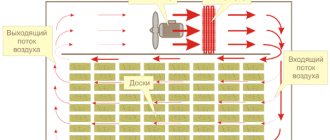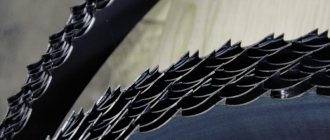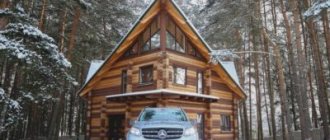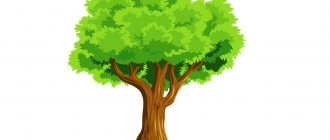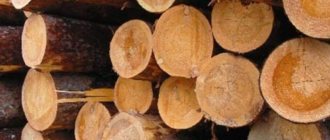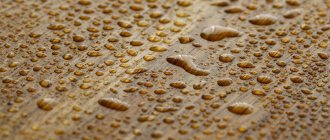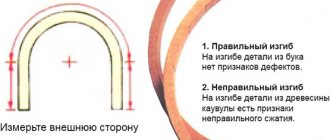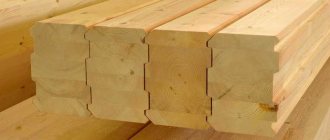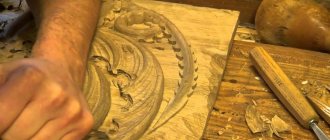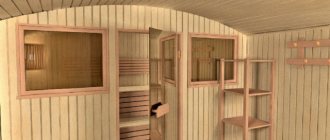The hardness of wood depends, quite logically, on the type of wood. Conventionally, wood can be divided by hardness into 6 groups: very soft, soft, medium hard, hard, very hard, hard like bone. Let's consider this division on the most famous varieties:
- very soft: willow, poplar, aspen, fir, spruce, white pine,
- soft: birch, alder, linden, larch, mahogany,
- medium hard: elm, walnut, black pine
- hard: oak, ash, apple, pear, cherry, teak,
- very hard: oak, hornbeam, beech, yew, white acacia, rosewood,
- hard as bone: ebony wood, coconut, guaiac wood.
Wood hardness is measured in Europe and America using different scales - Brinell and Jank, respectively; here is an example of the version we use, the Brinell scale.
| Name | Hardness | Name | Hardness | Name | Hardness |
| Aspen | 1.86 | Iroko | 3.5 | Pear | 4.2 |
| Pine | 2.89 | Nut | 3.5 | Wenge | 4.3 |
| Field maple | 2.5 | Teak | 3.5 | Zebrano | 4.5 |
| Larch | 2.5 | Cherries | 3.5 | Amaranth | 5.0 |
| Alder | 3.0 | Hornbeam | 3.7 | Rosewood | 5.5 |
| Cherry | 3.1 | Oak | 3.7 | Ipe | 5.9 |
| Sycamore | 3.2 | Beech | 3.8 | Kumaro | 5.9 |
| Afromorsia | 3.3 | Paduc | 3.8 | Olive | 6.0 |
| Birch | 3.5 | Sapele | 4.1 | Eben | 8.0 |
Wood hardness
Hardness is the ability of wood to resist the penetration of harder bodies, as well as cutting tools, nails and screws.
Since wood is cut in three ways, the hardness of the wood varies in these cutting directions.
The following types of hardness are distinguished according to the cutting directions:
— end (transverse);
- radial;
— tangential.
End (cross) cut - the tree is sawed perpendicular to the trunk and the direction of the grain.
End cutting of wood
Radial cutting is carried out along the trunk, along the radius, that is, through the center of the tree.
Radial cutting of wood
Tangential cutting is also performed longitudinally, but it passes outside the center, along the chord of the circle, and therefore peculiar patterns of growth rings are formed on the front surface of the cut.
Tangential cutting of wood
The hardness index of timber varies depending on the type of cut.
The lateral hardness of coniferous species is most often 40% lower than the end hardness, and for deciduous species it is 30% lower. The tangential hardness of, for example, oak, beech or elm timber is almost 10% higher than the end hardness. Most types of wood have approximately the same tangential and radial hardness.
According to the degree of hardness, all types of wood are divided into the following classes:
- hard as bone : ebony wood, coconut;
- very hard : oak, beech, white acacia, hornbeam, yew, rosewood;
- hard : oak, apple, pear, cherry, ash, teak;
- moderately hard - walnut, black pine, elm;
- soft : birch, linden, larch, alder, mahogany;
— very soft : spruce, white pine, poplar, willow, aspen, fir;
Hardwood is usually found in deciduous trees with broad, flat leaves that fall in autumn or spring, such as oak leaves. Because hardwood is also denser than softwood, its products are strong and durable, making it more valuable in carpentry.
Softwoods are primarily evergreen conifers that reproduce by cones. Since such trees grow faster, this wood is cheaper than solid wood. Soft wood is used in construction for the manufacture of beams, in furniture production, and is a raw material for the manufacture of paper.
But it is always necessary to remember that some deciduous trees actually have “softer” wood than coniferous trees.
General characteristics
Alder trees and shrubs are deciduous plants belonging to the birch family. In nature, there are about 30 species of this fast-growing plant. One of the reasons for cultivating alder is to quickly create a landscape and create shade. Alder prefers moist conditions and grows primarily in swamps and wetlands, along streams and rivers.
Trees and shrubs are monocultural, so each plant contains both male and female flowers. Flowers are presented in the form of male - longer and female. Once pollinated and matured, the female flowers become woody and somewhat similar in appearance to the cones found on pine needles. Inside there is a dry fruit, bitter taste, with a high protein content.
The edges of the alder leaf are serrated with a distinct vein running down the center of the leaf and a series of softer lateral veins. The leaves do not change color before leaf fall and fall green.
The three most famous types of these trees are:
- red alder, growing mainly in northwestern latitudes, reaches a height of up to 15 meters and lives up to 100 years;
- black alder, better known as European, reaching a height of 20 meters, living only 20 years;
- gray alder is much smaller than its species, only 5 meters in height, but valued for its ability to grow in infertile soil and the beauty of its spring blooms.
Typically a slender tree with smooth bark. In appearance, alder is distinguished from other trees by its early flowering, leaves that do not change color in the fall (slightly curled, they fall green) and cones hanging on the branches in winter.
Mostly gray and black alder are found in Russia. Black alder is also called sticky alder. In Russia, Moldova and Kazakhstan, black alder is listed in the Red Book.
Elasticity of wood
The elasticity of wood is its ability to change (within certain limits) its shape under the influence of external force and return to its original shape after the cessation of this influence.
Elasticity of wood - the ability to return to its original shape after the load is removed
Under short-term tensile load along the fibers, wood behaves almost perfectly elastic to a certain limit, and predominantly elastic deformations occur in it. That is, the deformation caused by tension disappears as soon as the load is removed.
The main indicator of deformability is the coefficient of proportionality - the modulus of elasticity E - the hypothetical stress in N/mm2, at which the length of the tested rod doubles. The elastic modulus E can vary widely even for the same wood species. Humidity has a noticeable effect on it.
The modulus of elasticity in tension and compression is virtually the same, as well as in bending.
| Wood | Estimated value of E along the fibers, N/mm2 (kg/cm2) |
| European conifer | 10000 (100000) |
| Oak, beech | 12500 (125000) |
When a force is applied at an angle to the direction of the fibers, as the angle increases, the elastic modulus E decreases. With forces acting across the fibers, the deformation due to the tubular structure of the cells is much greater than when acting along the fibers, which means the elastic modulus decreases significantly. The higher the elastic modulus, the stiffer the wood.
In construction practice, the average value of the elastic modulus E in the direction across the fibers is established, which for coniferous species is equal to 300 MPa (N/mm2), and for hardwood – 600 MPa (N/mm2). Consequently, the modulus of elasticity along the fibers is approximately 20 times greater than across them.
The designer needs to know the modulus of elasticity E of wood when calculating structures for the second group of limit states - states in which the normal operation of structures, structures is disrupted or their service life is exhausted due to the occurrence of unacceptable deformations (deflections, cracks), vibrations and other disturbances requiring temporary suspension of operation construction and its repair. That is, the second group is determined by the unsuitability of structures for normal operation.
There may be cases when the structure has not lost its load-bearing capacity, i.e. satisfies the requirements of the first group of limit states, but its deformations, for example, deflections, are such that they disrupt the technological process or the normal conditions for people in the room.
When calculating according to the second group of limit states, the maximum deflection fmax in the structural element is determined. As a rule, this is a single-span split beam of constant cross-section. The maximum deflection depends on what the beam is loaded with (concentrated force Q, distributed load q or moment M), and on what supports are at the ends of the beam (movable or fixed hinge, rigid embedment or free end), that is, on the design diagram beams.
The value of the maximum deflection fmax for each specific case can be found in any reference book on building structures. If you don’t have such a reference book at hand, then the deflection value can be calculated using a universal formula by first finding the standard value of the maximum moment Mn:
fmax = Mнl2 / 10EJx
Where:
Mn is the standard value of the maximum bending moment;
l - beam span (distance between supports);
Jx is the moment of inertia of the section, for a rectangular section it is equal to bh3/12;
E is the elastic modulus of the structural material.
Since wood consists mainly of polymers with long, flexible chain molecules, its deformability depends on the duration of exposure to loads.
The elastic properties of wood across the grain are used mainly in combination with another property, its viscosity - the ability of wood to hold nails, crutches, and screws. And this valuable quality of wood cannot be reproduced in any of the modern materials. When driving a nail into wood, elastic deformations occur, which provide sufficient frictional force to prevent the nail from being pulled out. The force required to pull out a nail driven into the end of the sample is less than the force applied to a nail driven across the grain.
As the density of wood increases, the resistance of wood to pulling out a nail or screw increases. The effort required to pull out screws (all other things being equal) is greater than for pulling out nails, since in this case the resistance of the fibers to cutting and tearing is added to friction.
Larch
The density of Siberian larch is 620-725 kg/m3 with a humidity of up to 12%.
Larch is a genus of woody plants of the pine family, one of the most common species of coniferous trees. This is the only genus of conifers whose needles fall off in the winter.
Larch wood is characterized by increased strength compared to oak. In addition to special strength and resistance to external influences, it is characterized by good color and structure.
Possessing high physical and mechanical properties, at the same time it requires a certain technological approach when processing it. Saw blades become heavily oiled when sawing. It is difficult to process with ordinary tools, but can be sanded and painted well. Prolonged exposure to water leads to a noticeable increase in hardness.
The cost of products or structures made from larch is higher than from pine, but the products are much more durable.
Plasticity of wood
The plasticity of wood is its ability, under the influence of prolonged loads, without collapsing, to retain its modified shape and to produce residual deformation. Deciduous wood has greater ductility than coniferous wood.
The plasticity of wood is the ability to maintain its modified shape under the influence of prolonged loads.
Plasticity can be attributed to both positive and negative properties. It increases with rising temperature and increasing humidity.
The fairly high plasticity of wood in an air-dry state, under normal temperature conditions, is used in construction as arched bent structures, in furniture production, and in the production of railings for stairs in private homes.
The great plasticity of wood in an air-dry state is used in the production of handrails for stairs
The technological operation of bending wood is based on its ability to deform relatively easily under the action of bending forces. The ability to bend is higher in deciduous ring-vascular species - oak, ash, etc., and in diffuse-vascular species - beech. Coniferous species have less bending ability.
Wood that is in a heated and wet state is subjected to bending. In loaded wood, when drying or cooling, part of the elastic deformations is converted into “frozen” residual deformations, which makes it possible to fix the new shape of the part under load.
Negative manifestations of the plasticity of wood affect mainly old beam floors of large spans, which sometimes give noticeable sagging only after decades. Wooden trusses that have stood safely for more than 100 years suddenly begin to experience a catastrophic increase in deflections due to plastic deformations in overstressed parts.
In some wooden structures, plastic deformations cause not only traditional sagging, but also their destruction.
Plastic deformations are the cause of not only sagging, but also destruction of wooden roof rafters
Cedar furniture
Kitchen sets, cabinets, sideboards, beds, tables and chairs - any furniture is made from cedar. She looks noble and expensive. Cedar is well processed, sanded, polished and painted. The furniture turns out to be strong and of good quality. The texture of the wood is easily visible under the covering translucent materials.
Cedar furniture is used for many years, moths do not grow in cabinets, and things do not grow moldy. The only thing worth noting is the impressive weight of cedar furniture. The tables are massive and heavy. Therefore, most often only countertops are made from the material.
Wood strength
The strength of wood is its ability to withstand certain loads without breaking. Denser wood is usually stronger.
Indicators of the mechanical properties of wood are usually determined using the following types of tests: tension, compression, bending and shear. Since wood is an anisotropic material, that is, a material with different properties in different directions, the direction of load action is indicated: along or across the fibers (in the radial or tangential direction).
Direction of normals for end, radial and tangential cuts
- End or cross section. Normal is the longitudinal axis N.
- Radial cut (passes through the axis of the trunk). Normal - R.
- Tangential cut (parallel to the axis of the trunk, passing through the tangent to the cross-sectional ring). Normal - T.
Due to the resistance of wood to external loads, internal forces arise in it. These forces per unit cross-sectional area (1cm2) are called stresses. The maximum stress preceding the destruction of a body is called tensile strength .
The tensile strength is determined on small, defect-free samples in laboratories using testing machines.
Compressive Strength
Compressive strength along the grain
compressive strength along the fibers is determined on a prismatic sample. A sample measuring 20 x 20 x 30 mm must include at least 4-5 annual layers.
Specimen for testing wood for compressive strength along the grain
The sample is gradually loaded until failure, while measuring the maximum load Pmax, H. A characteristic sign of failure of the sample under compression is the appearance of a fold formed as a result of loss of stability of the fibers.
Characteristic folds are a sign of sample destruction as a result of loss of fiber stability
Ultimate strength σ, MPa is calculated using the formula:
σ = Pmax/a∙b,
where Pmax is the maximum load, N
a ∙ b – cross-sectional area of the sample, mm2.
On average, for all domestic species at a wood moisture content of 12%, the compressive strength along the fibers is about 50 MPa (N/mm 2). Or 500 kg/cm2.
When wood works in compression along the grain, its strength is 2-2.5 times lower than the same tensile strength.
Ash
The density of wood is 690 kg/m3.
Ash is a genus of deciduous plants of the olive family, which has about 70 species. Ash grows singly or in groups in mixed forests, often together with oak, less often with conifers.
This is a modest neighbor of the oak tree, which for some reason has not become so famous, although it deserves all sorts of praise. Not inferior to it in strength and hardness, richness of texture, it is significantly superior to it in long-term resistance to deformation and impact strength. Therefore, it is ideal for the manufacture of stairs, flooring and other interior details. Currently, ash is increasingly becoming fashionable among furniture makers and parquet manufacturers. Regarding consumer qualities, we can say that ash, with standard care, lasts a long time and does not present any surprises. The cost of products made from it is close to the cost of products made from oak and beech.
Ash wood, which has high physical and mechanical properties, is widely used. It is used to make veneer, bent and carved furniture, railings and parquet, paneling, window frames and sofas, hunting and combat bows, and sports equipment.
Mechanical properties
Birch wood has high strength, resists shock loads well, and is difficult to split. Bending strength is average, bends well, elasticity is average.
Wear resistance is high, in these parameters it is almost not inferior to oak wood.
Resistance to fungal diseases and damage by insect pests is low. In the open air, birch products quickly become rotten and destroyed. Therefore, measures should be taken to protect wood from negative external factors and treatment with antiseptic materials should be used.
To dry birch wood, gentle conditions must be followed, as warping and cracking are possible. When drying under natural conditions, lumber must be bundled, which reduces the risk of warping of the workpieces. Drying under such conditions can last up to two years. In this case, the ends of the workpieces must be painted over with lime, paint, or sealed with paper using PVA glue. This will reduce cracking of the workpieces and minimize defects.
The fasteners hold well, but it is advisable to drill holes before using them. Although it is easier to screw a screw into a birch board than into an oak board, it also requires more effort.
Birch lumber
Spruce
The average density of spruce wood at a standard humidity of 12% is 445 kg/m3.
The total area of spruce forests in Russia is about 70 million hectares. Spruce lives 250-300 years.
The spruce wood is white, with a slight yellowish tint, and low in resin. Spruce is a low-density species. In terms of strength properties it is somewhat inferior to pine. It bends somewhat better than pine wood.
Spruce is a tree that is exceptional in its properties. One of these properties is musicality. Since ancient times, I have been making musical instruments from spruce, including stringed instruments. Novgorod harps of medieval Rus' were most often made from spruce. The wood is soft, light, and is used as a building material (boards, beams), for small crafts, and for processing into wood pulp. Used for the production of wood chemical products - paper, cardboard, cellulose. It is also used in ornamental gardening and park construction.

